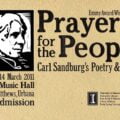I grew up in Toledo, Ohio surrounded by parks, art and music. I was lucky to attend the Saturday art classes at the Toledo Museum of Art and to wander through the galleries. Music in the Peristyle was magical, to see the Toledo Symphony, Errol Garner, Isaac Stern, Chinese Opera. And I wandered the park that was half a block from home – Walbridge Park – and watched the Buckeye trees through the seasons. All these experiences taught me the importance of arts and culture in defining communities and beyond.
I am a teacher, for as long as I can remember. Maybe I’m just bossy but I have made a career of it. I have taught 3rd grade (albeit briefly during a teacher strike); composition as graduate assistants (University of Toledo & University of Illinois Champaign-Urbana); composition and general literature at Bowling Green State University (Ohio); composition, general and Asian literature at Idaho State University; and composition, general British literature, the Modernists, the novel, literary criticism, history of literary criticism at University of Nebraska-Kearney. All of that (40 years) doesn’t make me a professional, necessarily, but certainly I am a curious, questioning person who asks questions all the time. What I love about teaching are those students who show curiosity and stamina to follow through investigation.
I’ve always used the visual arts and music in my classes in order to get students to see-hear something different from the canon literature, something that broadens the literary view beyond the book into its culture and people. One successful course was Walt Whitman, Carl Sandburg and Bob Dylan; others were Virginia Woolf and the Impressionists, Virginia Woolf and William Faulkner with Chuck Peek.
Around 2005 I changed a research focus British to American literature, from female to male authors. Some may have thought my research from Virginia Woolf to Carl Sandburg was a leap, but they were both Modernists, one in England, the other in America. They both demonstrated modernist characteristics that defined their cultures and Modernism in general. Most dominant for Virginia Woolf was Bloomsbury and visual art. For Sandburg it was the landscape, working people and folk music. You will find these interdisciplinary approaches in their writings.
Probably Prayers for the People: Carl Sandburg’s Poetry and Songs is my most loved achievement because these productions allowed me to bring all that I loved to one stage: music, poetry, stories, American culture, collaboration with artists. And so this Kearney Creates project is especially dear to me – to be able to recognize Kearney artists who have made my life in the Heartland worth it all. The program was recognized in the 2008 Nebraska Education Television Production which won a 2010 Heartland Emmy and has continued to air the program on Public TV.

